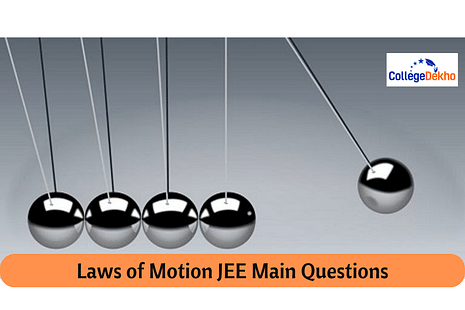Laws of Motion carries an average weightage of 6.6% in the JEE Mains. Candidates can expect 2-3 questions from this chapter. Students can access solved problems, and previous years' Laws of Motion JEE Main questions.

Laws of Motion JEE Main Questions 2025: The Laws of Motion chapter is one of the important topics of the JEE Main Physics syllabus. This chapter has a decent weightage in the JEE Mains 2025 exam as per last year's trends. Candidates should solve the questions and evaluate their performance. Preparing all the chapters with high weightage properly will help the candidate score well on the JEE Main 2025 exam. The authorities will soon release the syllabus for the JEE Main 2025. Some of the Laws of Motion topics from which questions can be asked are Force & Inertia, Newton’s first/second/third Law of Motion, the Law of Conservations of Linear Momentum (its applications), Concurrent forces and Equilibrium, Kinetic and Static Friction, and Laws of Fiction, and others.
Students should solve all the questions provided here to practice the Laws of Motion chapters from the Physics Syllabus of JEE Main 2025 . Before we move on to the important questions for this chapter, have a look at the topics that need to be focused on while studying this chapter.
Also Read:
| Kinematics Weightage in JEE Mains 2025 | Units and Dimensions Weightage in JEE Main 2025 |
|---|---|
| Kinematics JEE Main Questions 2025 | Laws of Motion Weightage in JEE Mains 2025 |
What To Study in Laws of Motion?
Here are the topics that applicants should not miss while their preparation for this chapter.
- Force & interia
- First/second/third law of Newton
- Momentum
- Impulses
- Law of conservation of linear momentum (its applications)
- Concurrent forces and equilibrium
- Laws of friction
- Kinetic and static friction
- Rolling friction
- Uniform circular motion dynamics
- Centripetal force (its applications)
JEE Main Laws of Motion Important Questions 2025
Check the practice important questions from previous years for the chapters ‘laws of motion.’
- While peddling a bicycle, the force of friction exerted by the ground on the two wheels is such that it acts
- in the backward direction on the front wheel and in the forward direction on the rear wheel
- in the forward direction on the front wheel and in the backward direction on the rear wheel
- in the backward direction on both the front and rear wheels
- in the forward direction on both the front and rear wheels
Correct Answer: (a)
- A car is moving in a circular horizontal track of radius 10 m with a constant speed of lOm/s. A plumb bob is suspended from the roof of the car by a light, rigid rod. The angle made by the rod with the track is (g = 10 m/s2).
- zero
- 30°
- 45°
- 60
Correct Answer: (c)
- A block of mass 0.1 kg is held against a wall, applying a horizontal force of 5N on the block. If the coefficient of friction between the block and the wall is 0.5, the magnitude of the frictional force acting on the block is
- 2.5N
- 0.98N
- 4.9N
- 0.49N
Correct Answer: (a)
- A block of mass 2 kg rests on a rough inclined plane, making an angle of 30° with the horizontal. The coefficient of static friction between the block and the plane is 0.7. The frictional force on the block is
- 9.8 N
- 0.7 x 9.8 x√3N
- 9.8 x √3N
- 0.7 x 9.8 N
Correct Answer: (a)
- A ship of mass 3 x 107 kg initially at rest is pulled by a force of 5 x 104 N through a distance of 3 m. Assuming that the resistance due to water is negligible, the speed of the ship is
- 1.5m/s
- 60 m/s
- 0.1 m/s
- 5 m/s
Correct Answer: (c)
- If the resultant of all the external forces acting on a system of particles is zero, then from an inertial frame, one can surely say that
- linear momentum of the system does not change in time
- the kinetic energy of the system does not change in time
- angular momentum of the system does not change in time
- the potential energy of the system does not change in time
Correct Answer: (a)
- A piece of wire is bent in the shape of a parabola y = kx2 (y-axis vertical) with a bead of mass m on it. The bead can slide on the wire without friction. It stays at the lowest point of the parabola when the wire is at rest. The wire is now accelerated parallel to the x-axis with a constant acceleration a. The distance of the new equilibrium position of the bead, where the bead can stay at rest with respect to the wire, from the y-axis is
- a/gk
- a/2gk
- 2a/gk
- a/4gk
Correct Answer: (b)
- Two blocks of mass m1 = 10kg and m2 = 5kg, connected to each other by a massless, inextensible string of length 0.3 m, are placed along the diameter of a turntable. The coefficient of friction between the table is 0.5, while there is no friction between rr^ and the table. The table is rotating with an angular velocity of lOrad/s about a vertical axis passing through its center O. The masses are placed along the diameter of the table on either side of the center O such that the mass m1 is at a distance of 0.124m from O.The masses are observed to be at rest with respect to an observer on the turntable.
- Calculate the frictional force on m1.
- What should be the minimum angular speed of the turntable so that the masses will slip from this position?
- How should the masses be placed with the string remaining taut so that there is no frictional force acting on the mass m1?
Correct Answer: (a)
- As per the given figure, a weightless pulley P is attached to a double-inclined frictionless surface. The tension is the string (massless) will be (if g = 10m/s2)
- (4√3 + 1)N
- 4(√3 + 1)N
- (4√3 - 1)N
- 4(√3 + 1)N
Correct Answer: (b)
- Two bodies of mass m1=5kg and m2=3Kg are connected by a light string going on a smooth light pulley a smooth inclined plane as shown in the figure. The system is at rest. The force exerted by the inclined plane on the body of mass m1 will be:
- 30 N
- 40 N
- 50 N
- 60 N
Correct Answer: (b)
- Two masses of m1=5kg and m2=10kg connected via an inextensible string over a frictionless pulley are moving as shown in the figure. The coefficient of friction of a horizontal surface is 0.15. The minimum weight m that should be put on top of m2 to stop motion is:
- 18.3 g
- 23.3 g
- 43.3 g
- 10.3 g
- A body is thrown vertically upwards. Which one of the following graphs correctly represents the velocity vs time?
Applicants can judge their performance before the JEE Main 2025 by solving these questions above. For more such updates, stay tuned with CollegeDekho.
Also Check:
For more articles and updates on Laws and Motion JEE Main Questions 2025, stay tuned with Collegedekho !
Are you feeling lost and unsure about what career path to take after completing 12th standard?
Say goodbye to confusion and hello to a bright future!

FAQs
Although maximum candidates usually require one or two years to prepare for the JEE Main and the JEE Advanced exam, candidates can also ace these exams with a tight study routine of 6 months.
HC Verma is considered to be a good book for the JEE Main preparation. It comprises good explanations and many practice problems. However, it is not enough for the preparations and candidates are required to study the NCERT textbooks as well.
The physics section in the JEE Main exam is typically of moderate level of difficulty. It comprises a mix of numerical and concept-based questions.
Candidates must keep in mind that there is no requirement of 75% marks in class for appearing in the JEE Main exam. The JEE Main eligibility criteria of minimum 75% marks in class 12 is required at the time of admission in NITs, IIITs and GFTIs. Candidates can apply and appear in the JEE Main exam irrespective of their class 12 marks.
The JEE Main exam has a total of 90 questions from all three subjects. The JEE Main exam has 30 questions each from the subjects of Physics, Chemistry and Mathematics. Out of 30 questions, there are 20 multiple choice questions and 10 are questions with numerical value answers.
The official syllabus of JEE Main entrance exam and NCERT books cover almost all topics, and it is preferred by the candidates for their preparation. The syllabus of JEE Main and that of CBSE's Class 11 and 12 board is almost the same. Candidates can consider NCERT books as one of the best reference materials for the JEE Main exam.
Some NITs and IIITs which candidates can get with 35000 rank in the JEE Main entrance exam are Indian Institute of Information Technology Kalyani, National Institute of Technology Mizoram, Indian Institute of Information Technology Dharwad, National Institute of Technology Nagaland, and National Institute of Technology Manipur.
The exact marks to be obtained for getting the 99 percentile in the JEE Main exam depends on the difficulty level of the paper. If the JEE Main question paper turns out to be easy, then marks secured by most of the candidates are good and the higher percentile is relative and gets pushed for higher marks.
No, 40 is regarded as a very good score in the JEE Main exam. Since 85 to 95 percentile is considered to be good for admission into NITs, and IITs, securing anything less than that is not a good score for the General, OBC, and EWS candidates. With this score, such candidates can barely make it through a few engineering colleges of India.
Was this article helpful?





















Similar Articles
GATE CS Question Paper Difficulty Level Trends: A detailed analysis
JEE Main 2026 Chemistry High Priority and Low Priority Chapters
Are JEE Main Study Groups Worth It? Detailed Pros and Cons for 2026 Aspirants
How to Prioritize Physics Chapters Based on JEE Main 2026 Weightage and Difficulty
GATE 2026 Mechanical Engineering Expected No. of Questions Topic-Wise
GATE 2026 Civil Engineering Expected No. of Questions Topic-Wise